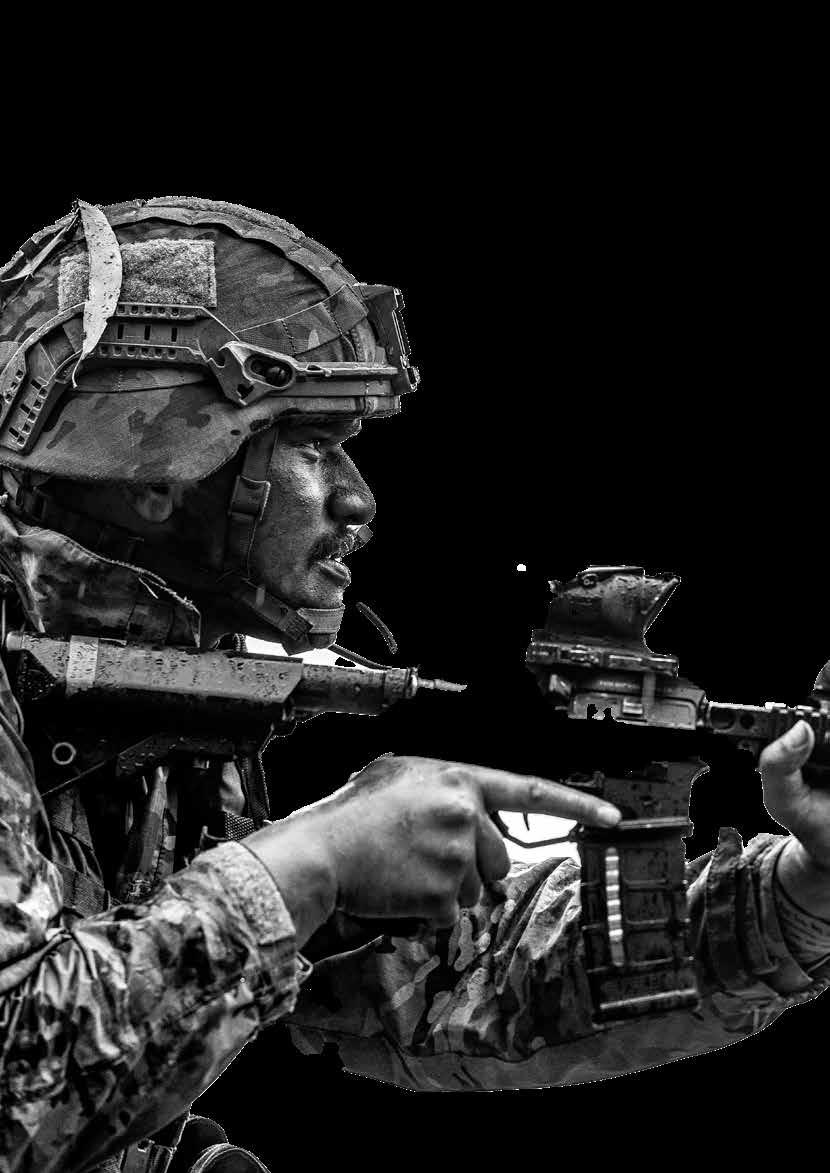









The future depends on what you do today.– Mahatma Ghandi
In addition to meeting our day-to-day requirements, particularly delivering on the outputs required of us by Government, we must always keep an eye on ‘what’s next’. The need to think about the drivers of change that are shaping the future operating environment and therefore our future doctrine, TTP’s and capabilities must continue to be assessed, and their implications always considered even when making today’s decisions.
Being comfortable operating in an environment of continuous improvement, looking to incremental change to how, at all levels, we prosecute operations is both important and supports our on-going pursuit of professional excellence – but it only achieves part of this requirement. At a higher level we must seek to understand how the future Army will operate in a constantly changing, incredibly dynamic, operating environment. We must ensure that our future force development, structures and capability acquisitions are both relevant and of value. And, we must understand the direction of travel of our key partners and ally to ensure that the requirement to be interoperable continues to be met.
Some of this we can do internally. Within HQ NZDF there are a select number of staff whose role it is to assess and develop future defence concepts and capabilities. Within Army, it is the Strategy team that leads our thinking in this space. Over the last year they have undertaken significant work to develop Capstone Orders, recently released to Army with copies to be distributed in the coming weeks, directing how we will achieve in the short-medium term sustained operational readiness. In particular, the Orders reposition Army to better force generate the Motorised Infantry Battle Group (MIBG), Special Operations Task Group (SOTG), Land Support and Reserve Force capabilities ensuring that, as part of the Joint Force, we can both better integrate with our coalition partners, and operate independently where our Government requires us to do so.
Taking a longer term ‘futures’ view Army Strategy is also bringing together Army’s Experiment for 2024, to be held early July, to examine how we better generate future force elements and, in particular, what a future force structure for Army might look like to contribute the MIBG as part of an ANZAC Brigade within a Multi-national Division. The Experiment will draw on a range of subject matter experts from across Army and Defence and utilise the Decisive Action Training Environment to collect data and develop our thinking regarding Army’s priorities for modernisation, personnel, and readiness. Engagements in the last month with the Australian Army, including visits from Forces Command and 7 (AS) Brigade, have enabled us to better understand their futures thinking and how we might look to position ourselves to achieve the level of integration sought through Plan ANZAC. Equally, we have recently
committed force elements to two key US Army activities, Project Convergence and the United Pacific Wargame Series, both of which allowed us to continue to develop our understanding of what a future NZ Army contribution to higher end coalition operations might look like. Project Convergence focused on the identification and development of land capabilities able to effectively integrate into the US’s wider Combined Joint All-Domain Command and Control effort. A truly impressive activity of a scale and level of complexity that the New Zealand Army, quite simply, could never replicate. Importantly, it provided an opportunity for us to confirm that we are on track with respect to our own Networked Enabled Army Programme and, more specifically, that we can effectively network and move data alongside key partners.
With a focus on sustainment, the US Army in the Pacific’s Unified Pacific Wargame Series allowed our participants to understand US thinking regarding joint warfighting concepts in the wider Indo-Pacific region. In particular, the Kiwi attendees gained an appreciation of how a joint campaign in our region might be planned and conducted, the capability investments that need to be made and why, and shifts in thinking regarding operating concepts. Again, an invaluable activity for our Army as we consider our future.
Work in these areas, and there are others, is critical to ensuring that, as an Army, we continue to think about and prepare for the future. Yes, be good at what you do today – in fact, stuff it, be the best – but don’t take your eye off the next challenge, nor the next opportunity. Because if we do, and as often quoted, it is ‘by failing to prepare, that you are preparing to fail.’

A team from Queen Alexandra’s Mounted Rifles won the coveted 1st (NZ) Brigade Skill at Arms (SAA) competition at Waiouru Military Training Area recently.
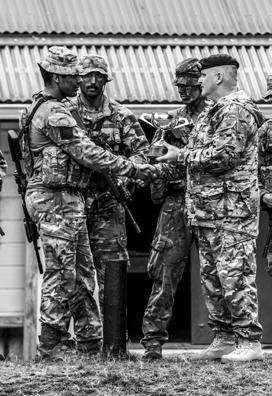
The competition consists of a range of activities based around the four military core skills of “shoot, move, communicate and medicate”.
Over 42 hours, teams of 10 soldiers walked close to 40 kilometres between stands carrying around 35 kilograms on their back, surviving on minimal sleep and food, and managing changing and arduous conditions.
Each of the 13 stands they encountered tested core military skills and included close armed combat, night shooting, constructing a barbed wire fence, coordinating an artillery and air response while under attack, crossing a body of water using a pack as a flotation device, and administering first aid in the field. The competition culminated in the Falling Plate shoot – the ultimate test of skill, accuracy and speed.
Colonel Ben Bagley, Commander 1st (NZ) Brigade said his role is to ensure NZ Army soldiers – led by professional and trusted leaders – are physically and mentally prepared to meet the rigours of military operations.

“Skill at Arms is designed to test the resilience, endurance, teamwork, and leadership of those soldiers taking part. Competitions where core skills are tested in a pressure environment is an effective way to see how we’re doing.”
“These competitions are important as they benchmark us,” he said.
“They let us know exactly where we are in our core business and identify what we’re good at, and more importantly what we’re not good at. I saw a lot of soldiers really committed to our profession and trying to achieve the best possible results, and that was pleasing to see.”
2nd /1st Battalion won the Falling Plate trophy. QAMR team members were: CPL Ryan Sain (Section Command); LCPL Rhys Tomlinson (2IC); TPR Will Simpson; TPR Henry King; TPR Carter Hall, TPR Kaleb Terry; TPR Johnny Ngo; PTE Richards; TPR Regan Aylward; TPR Levani Rova; LCPL Jordan Bremner (Res1); TPR Boston Tahana (res2); and supported by CPL Jake Low (Coach/Driver) and and LT Luke Sheehan (Manager).
from 38 Combat Service Support Company (38 CSS Coy) and 10th Transport Company (10 Tpt Coy) took to the rugged Kaipara Air Weapons Range this month for Exercise Active Edge.

The soldiers trained in night vision goggle vehicle operation and for selected ARES soldiers, training to gain their night vision goggle operator qualification.
The exercise included driving activities, beginning with an introduction drive and two progressively harder routes, over varying terrain.
38 CSS Coy undertook static live firing off Medium Heavy Operational Vehicles at targets out to 200 metres at night, engaging targets using night vision goggles and various illumination methods, with firing up to 600 metres during the day.

“The training simulated engaging the enemy from a static sentry point and aimed to improve the soldiers’ night shooting. The exercise provided a baseline capability from which 38 CSS Coy can build on and be combat ready, if they are required to support the Regular Force,” says Major Timothy Cocks, Commanding Officer, 10 Tpt Coy.
With most training occurring in Waiouru, Kaipara Air Weapons Range provided many benefits, as the proximity to Auckland allowed more ARES soldiers the opportunity to attend the training for longer.
“Kaipara is also something different for the soldiers from 10 Tpt Coy, a different AO which they are not familiar with. There are also a number of drivers who have never visited the Auckland region and the environment it offers does challenge them and increases their experience base which they can draw on whilst on operations,” he says.
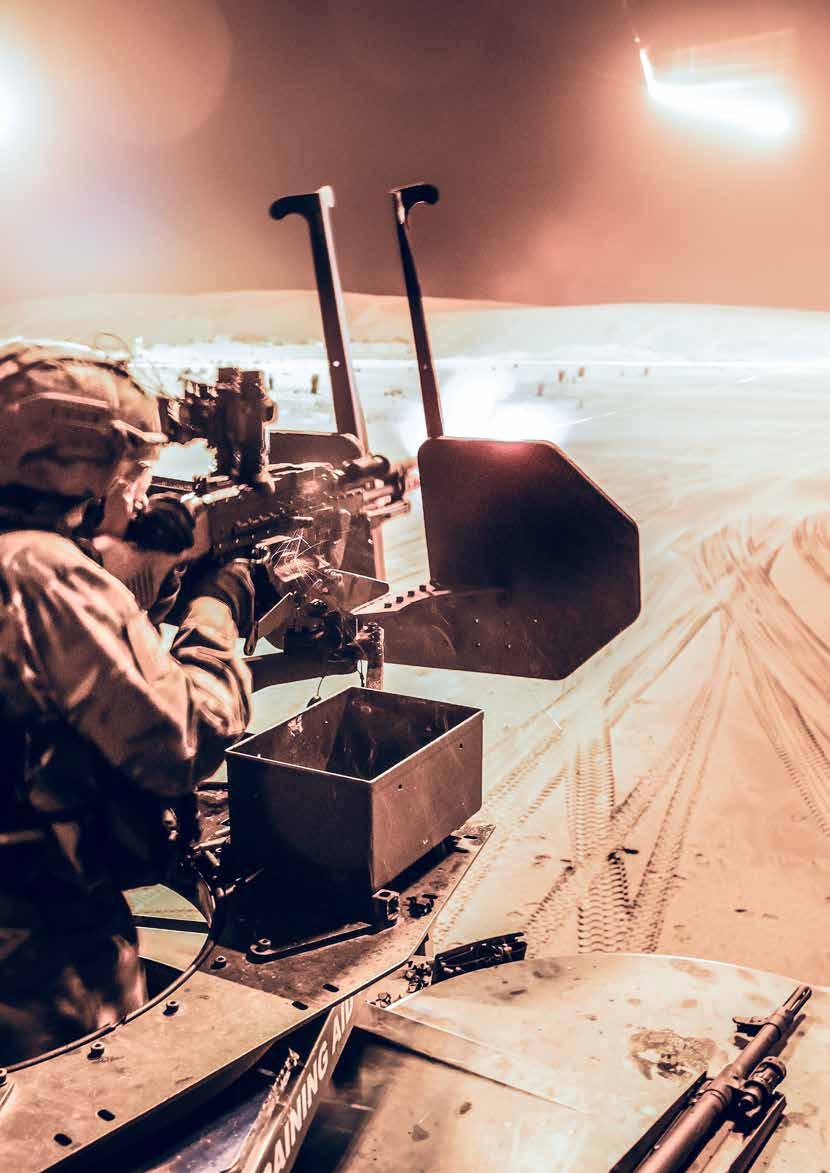
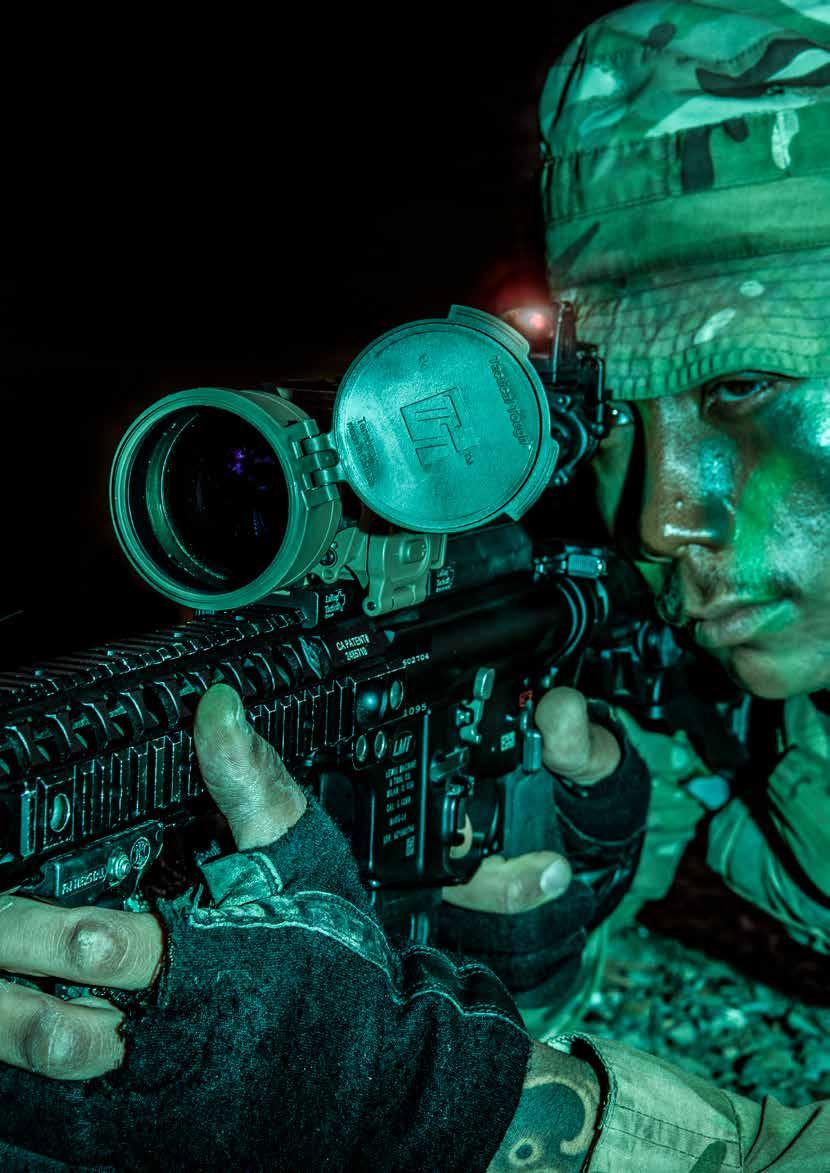


Being able to detect, recognize and identify threats is an increasingly critical factor to a soldier’s lethality and survivability on the modern battlefield – we need to be able to see an adversary before they see us in order to have the freedom to dictate any engagement action and avoid becoming targeted ourselves.
– SSGT Noema Taero – Small Arms Instructor, Combat School
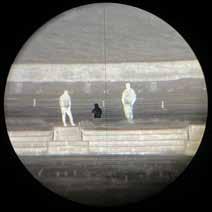
(black).
The NZ Army is set to receive new thermal optics for the MARS-L individual weapon system, enhancing soldiers’ ability to engage targets by day and night.
The Night Vision Equipment Programme is delivering the DRAGON C12-XR (DRAGON) into service throughout 2024, through the In Line Weapon Sight – Short Range Project. Following evaluation of available solutions on the market, the DRAGON was selected for the NZ Army based on its impressive detection capabilities, ease of use, and versatility of use across all section weapon systems. Delivery and acceptance of the DRAGON is almost complete and introduction into service has started with an initial quantity of sights being released to Combat School for incorporation into small arms courses. Participants put the DRAGON through its paces on the Purpose Built Range Conducting Officers Course being run by Combat School Weapons Wing in Waiouru earlier this month, and next month students on the All Arms Field Firing Safety Course will get to run the DRAGON out during live field firing activities.
The DRAGON is primarily designed to be used in clip-on configuration, in conjunction with the advanced combat optical gunsight (ACOG) as part of the overall MARS-L weapon system; however, it can also be used as a standalone thermal sight with built-in digital reticles that are customized to NZDF ammunition natures for the MARS-L, LSW 7.62 and Mag 58 machine gun. The project is also working through additional ongoing enhancements for the DRAGON which involve the provision of specialized flip-mounts for more effective utility on machine guns, a wireless remote keypad and enhanced firmware update packages.
Army units can expect distribution of DRAGON sights to occur from June 2024, with operator training being cascaded into unit training schedules in the subsequent months. Project consultation with users is ongoing and training opportunities in the second half of 2024 are being identified for employment of the DRAGON during unit exercises.
The project team is looking forward to engaging further with stakeholders around New Zealand and seeing the DRAGON in action.
DRAGON thermal image of two soldiers (white/hot) stand next to a thermal target
The last few months have flown by and we’re already gearing up for Anzac Day. Tempo is up, and it’s good to see us taking purpose to action in so many ways. Thinking back to my time as a young soldier I recall slower times. I remember that despite a lack of material we always had things to do, new learning to take on, annual trips, close-knit teams and some top notch leaders. I wonder if a similar ‘back to basics’ approach might be the right direction for us to take in tougher economic times?
In a recent ALC Lead Leaders forum an NCO asked, – ‘SMA, if you had your career again, what would you tell yourself, advise us or maybe do differently’? It was a question that made me pause. This column looks at a couple of themes we discussed as a forum, and are offered here for soldiers plotting their next waypoint.
Earn the Uniform. Our Army carries a great heritage, deep culture and a hard won legacy. Our uniforms are a window to the past. Our New Zealand service dress tab and the small NZ flag are some of the most important features. Wearing the uniform speaks to a commitment to this shared history and our dedication to each other, and to our nation’s security. When we wear the Army uniform in any of its forms, you have to earn and respect it.
Be comfortable not knowing it all. New Zealanders are activators and innovators – and patience is a rare virtue. We seek to gain understanding quickly, often rushing to the end and sometimes missing the deeper point. I’d suggest the opposite – listen to your instructors and training officers, soak-up some enlightening and funny stories, connect with other military generations, be inquisitive and develop a keen interest for learning. Everything else will come in time.
Understand the Profession. There are cycles and sine-waves to navigate before you can fully understand the distinctive “military calling”. Remember that our profession is a unique occupation. These differences are what makes it special. It’s something that society trusts and needs (even if they don’t always say it or show it), it sets and maintains high values and standards, it demands continual improvement, and it’s always evolving.
4
Master your Trade. From basic recruit training, employment-specifications, through to Corps, All-Arms and specialist training continuums – we have a thorough system of training. While I expect every individual to be soldier first – the mastery of each trade contributes to the whole. While time is not the total sum of competence, it acts as a guide to how we approach and conquer the many aspects of an operational specialty. Be sure to master yours.
5
Ride out the bumps – embrace the special. A soldier’s life isn’t always easy, but riding out the hard times brings rewards. Service challenges like pay, service conditions, leadership, postings and technology crashes can lead us to think the grass is greener elsewhere. It rarely is. Army service can be hard, but it is special. It’s easy to forget the unique environment we work in, the close camaraderie and the fulfilling opportunities it offers.
Train, …then educate. Education is important, but our first role is readiness. Training is about specificity and repetition. It results in deep individual and collective competence and it strengthens the force. Building the ‘sets and reps’ brings a proficiency to take life and to save life when needed. Formal learning, professional-development and military education are important – but shouldn’t be placed ahead of mastery of the fundamentals.
Make friends, find, and be a mentor. Army’s people are its platform – our value-add is the mass and wide range of specialist skills we engender. It’s a great place to form close bonds and lasting mates. But best friends are not always the best coaches. In time find yourself a mentor, someone knowledgeable and frank; not afraid to tell you the truth, and prepared to hurt your feelings if needed to set you on the right path. You want to aim to be that person for someone else, sometime in your future career.
I’m conscious there’s a bit to unpack here – but readers can pick and choose what fits for you. As you look around your team, Unit or Regiment, identify people you trust and want to emulate. Importantly, don’t be afraid to seek advice – it’s what moves a ‘job’ to a ‘livelihood’, and an ‘occupation’ to a fulfilling ‘profession’. Get after it.
Major Nigel Cole has been awarded a Land Component Commander’s Commendation for his exceptional devotion to duty and performance over and above what is expected throughout his deployment to the Solomon Islands in 2022.
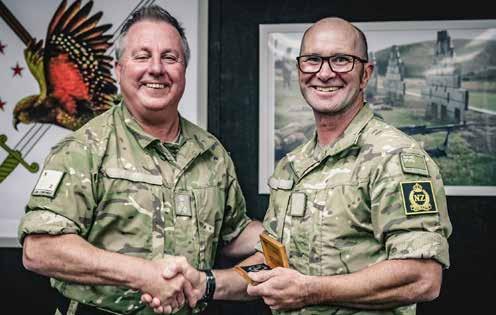
Following the initial deployment of NZDF personnel to Honiara, Solomon Islands, in 2021 under Operation Solomon Islands Assistance (Op SIAST), Task Group 637.3, Major Cole deployed as the Task Group Executive Officer and NZDF Senior National Officer in 2022. The NZDF contributes personnel to the Multinational Police Support Group (MPSG). The MPSG is an ADF led Task Group of combined Australian, New Zealand, Fiji, and contracted health personnel operating under the Solomons’ International Assistance Force (SIAF).
In 2021 Major Cole transferred from the Regular Force (RF) to the Reserve Force (ResF) to 5/7 Battalion, Royal New Zealand Infantry Regiment. Shortly after transferring, he answered the call for a short-notice nomination for Op SIAST.
On arrival in the Solomon Islands the NZ contingent had to overcome the difficulties of COVID-19 protocols and isolation requirements. Recognising the human complexities within the Force and acting on them, Major Cole employed his well-refined interpersonal skills to build a strong rapport with the multiple stakeholders both within, and external to the Task Group.
“The Fijians, along with the ADF Community Engagement Team, were instrumental in fostering local relationships and goodwill. The Fijian community projects included re-building a Medical and Community Health Centre at Burns Creek, a low socio economic area with a transient community who were previously unsupported by government. This gave them a sense of belonging and stability which helped build trust. The Australian Minister for Foreign Affairs opened the centre which was a big step forward for the community.”
It was through Major Cole’s level of interaction that the Task Group’s interagency relationships enabled direct support to SIAF operational influence and also directly contributed to regional situational awareness for the Task Force and wider Australian and New Zealand Strategic Headquarters.
“I was extremely well supported by our New Zealand contingent throughout the deployment. Our team conducted themselves to the highest standards of the NZDF and performed over and above expectations,” he says.
A highlight of his deployment was the 80th Commemoration of the Battle of Guadalcanal, marking the first major Allied landings in the Pacific campaign during the Second World War. The commemorations were attended by the then New Zealand Minister of Defence, Hon Peeni Henare, and NZ’s Secretary of Defence, Andrew Bridgman, Victoria Cross recipient, Willie Apiata, and Commander Joint Forces New Zealand, Rear Admiral Jim Gilmour. Although the planning was led by the NZ High Commission, the contingent supported activities and facilitated briefings, liaising closely with the NZ High Commission and US Consulate.
As the Task Group mission and characteristics changed, Major Cole was instrumental in facilitating long-term life support and staging activities for future Australian and New Zealand forces. This included a detailed analysis of training and mission requirements to make sound training and personnel recommendations to his Command Team, which vastly improved the reputation and capability outputs for the Task Group.
Major Cole re-engaged with the RF in November 2023 and is now serving as the Executive Officer, Army Command School based in Waiouru Military Camp.
Land Component Commander Brigadier Matt Weston presents Major Cole with his award.Supporting the Army through his civilian media industry experience, his strong links to his Māori identity, or in uniform as a Reserve Force Combat Driver for 38 Combat Services Support Company (38CSS Coy), has given Private Hoani Smith a real sense of whanaungatanga.
“I want to support the Army any way I can, whether that’s through my civilian skills, cultural identity or as a uniformed soldier.” He’s been doing just that too. Joining the Reserve Force in 2022, Private Smith was the only Reservist to attend the Tāne Wānanga at Rongomaraeroa o ngā hau e whā Marae, New Zealand Army National Marae, Waiouru in July last year. Contributing to the cultural resilience of the Army through the Wānanga gave Private Smith a deeper understanding of Ngāti Tūmatauenga, cemented his relationship around his service in the NZ Army, and gave him an opportunity to share a reservist voice in a tikanga based environment.
The synergy between his role with the indigenous broadcaster and the Army is very real. Even the values are similar, focusing on outcomes including commitment, maintaining high standings, having courage and being respectful.
As the Media Delivery Manager at Whakaata Māori (Māori Television), working there since its inception 20 years ago this year, Private Smith’s skill set in the many roles he’s performed has helped bridge a gap between civilian media outlets and military personnel.
Attending the recent Senior Enlisted Leaders Conference (SELCON24) as the Plenary Production Advisor/Supervisor, he was able to provide advice on the media and production space; bridge the gap between the army delivery team and the audio visual support team at Tākina Wellington Convention and Events Centre; and contribute to the smooth running of the conference.
It’s about a sense of belonging and the obligations that go with it.
– PTE Hoani Smith

“I needed to make sure everyone was where they needed to be and provide solutions for any issues that arose, make sure the MCs were comfortable, provide coaching where necessary, and work as liaison with presenters and their talent; the production gear was set up correctly, the stage was a workable space and all the presentations were loaded into the system. Basically that everything ran smoothly in the media space. Forming a strong working relationship with both teams and setting the right expectation was key to bringing multiple elements together each day.
“I found the networking and involvement amazing and can see how both the military and Whakaata Māori can benefit from this type of experience and exposure. Observing how the Army ran both the lead up and the conference showed me how different efficiencies could be brought into my civilian employment too.”
Although Private Smith wore his Whakaata Māori clothing for the day-to-day work, he wore his service dress for the Pōwhiri.
“I was keen, and proud, to show I was also a soldier of Ngāti Tūmatauenga. Performing our army haka for our foreign guests, alongside so many super experienced soldiers, was definitely a personal highlight in my short career.”
With the opportunity to have his civilian skills and values moving to the same beat as the Army and to enhance the Army profile and mana through this action, has given the community focused soldier the feeling he has the best of both worlds, as the saying goes.
“It’s been really cool to have a voice. At the Wānanga, everyone had a chance to speak, and to speak from the heart. Among other things we spoke about how to keep our culture alive and significant, and our personal challenges we’ve faced in the Army as well as making such all-important connections. I felt our Marae was a place I could connect with and return to. It felt empowering to use our cultural tools in such a positive format, and to be reminded we’re not just an Army, we’re Ngāti Tūmatauenga.”
Private Smith has recently completed his MHOV driver course and says it’s been great to be able to utilise his driver skills and contribute now that he has his HX60 military driving license.
Any Defence Recruiting enquiries can be directed to 0800 1 FORCE. Each Reserve Force company has its own training programme in line with its battalion’s training focus. Company level training typically occurs one weekend a month with platoon level training occurring one night a week.

The Soldier Personal Protection Equipment (SPPE) project is delivering head, torso, hearing protection and personal load carriage systems in the form of the TBAS Plate carrier, and the OPS-CORE Hi cut ballistic helmet providing level 3 (NIJ compliant) ballistic protection.
The hearing protection is in the form of PELTOR level 5 hearing protection and a mix of harness and chest webbing/pouches for personal load carriage (All Coyote Tan pouches are being withdrawn from service and replaced with Multicam© pouches).
The Plate carrier and helmet will be individually sized, will include non-ballistic training plates and come packaged in a large black roller bag. All items will be issued to soldiers as a whole of service loan. NEA integration will be supported through the issue of OPS CORE AMP Communications headsets in parallel with the NEA programme roll out. These will be issued to specific units only as part of the NEA integration with SPPE.
The items will be delivered in two tranches, with tranche 1 undergoing acceptance by the project team in July 2024. The initial tranche 1 delivery to soldiers is under planning now in accordance with the Land Component Commander’s delivery priorities. Tranche 2 will be delivered direct to the remainder of individuals by mid next year.
The SPPE project delivers level 3 head and torso protection for use in low – medium ballistic threat/non blast operating environments in a lighter more comfortable form. IT DOES NOT REPLACE the current in service Tyr EPIC Body Armour and full cut P4 Viper helmet which provides level 4 protection and is retained for higher threat (including blast) environments.
TBAS Plate carrier Ops Core high cut helmet
In last month’s Army News we introduced a series on strength training by looking at the effects of muscle protein synthesis and muscle protein breakdown on muscle growth and overall strength. In this issue we look at the role of the nervous system when training for strength. The nervous system plays a fundamental role in strength training, influencing everything from muscle activation to coordination, and motor learning.
Let’s have a look at some key contributions of the nervous system:
1. Muscle Recruitment and Activation: When you lift weights or perform any resistance-based exercise, your nervous system signals your muscles to contract. This process involves the recruitment of motor units, which are comprised of a motor neuron and the muscle fibers it innervates. Initially, your body activates smaller, slower motor units (slow-twitch muscle fibers) before recruiting larger, faster ones (fasttwitch muscle fibers) as the intensity of the exercise increases. Strength training helps to improve the efficiency of this recruitment pattern, allowing for greater force production over time.
2. Motor Learning and Coordination: Strength training enhances the coordination and synchronisation of muscle groups involved in specific movements. Through repetition and practice, the nervous system refines movement patterns, making them more efficient and precise. This phenomenon is known as motor learning. As you progress in strength training, your nervous system becomes better at coordinating muscle actions, leading to smoother and more controlled movements, which ultimately improves strength output.
3. Central Nervous System Adaptations: Strength training induces adaptations within the central nervous system (CNS), which includes the brain and spinal cord. These adaptations can include increased neural drive, which refers to the intensity of the signals sent from the CNS to the muscles. Over time, strength training can enhance neural adaptations such as improved motor unit recruitment, rate coding (the frequency at which motor neurons discharge signals), and synchronisation of motor unit firing. These changes contribute to greater force production capabilities.
4. Inhibition of Antagonistic Muscles: During strength training opposite muscles contract and relax, e.g., during a bicep curl (the lift) phase, the biceps will be the agonist and the triceps the antagonist – the muscle that is relaxing or lengthening, opposing the action being performed is referred to as the antagonist. During strength training movements, the nervous system also plays a role in inhibiting antagonistic muscles. This inhibition allows for more effective muscle contraction of the agonist muscles (the muscles primarily responsible for the movement) and prevents energy wastage from opposing forces.
5. Reflexive Responses: The nervous system also facilitates reflexive responses that contribute to strength output and stability during lifting movements. Reflex arcs, such as the stretch reflex, help to maintain muscle tone and stability by causing rapid responses to changes in muscle length. These reflexive mechanisms contribute to the overall effectiveness and safety of strength training exercises. In summary, the nervous system synchronises a complex series of events during strength training, including muscle recruitment, coordination, motor learning, CNS adaptations, inhibition of antagonistic muscles, and reflexive responses. Improving the function and efficiency of the nervous system is crucial for optimising strength gains and performance in resistance training activities.
The question now is how can we effectively improve the function of the central nervous system (CNS) with strength training? To answer this, there are certain training modalities that may have a more pronounced impact on CNS adaptations. Below are some methods that are particularly effective for stimulating the CNS:
1. Heavy Resistance Training: Highload resistance training, such as lifting weights at intensities close to your maximum strength capability (around 85–100% of your one-repetition maximum or 1RM), places significant demands on the CNS. This type of training recruits a large number of motor units, stimulating adaptations in neural drive, motor unit recruitment, and rate coding. Exercises like squats, deadlifts, bench presses, and overhead presses performed with heavy loads are particularly effective for CNS stimulation.
2. Explosive or Power Training: Power training involves performing movements with maximal force output in minimal time, emphasising speed and explosiveness. Exercises such as plyometrics, Olympic lifts (e.g., clean and jerk, snatch), and their variations require rapid recruitment of motor units and coordination of muscle groups, leading to CNS adaptations geared towards enhancing force production and power output.
3. Complex Movements and Multi-Joint Exercises: Compound movements that engage multiple muscle groups and joints simultaneously, known as compound or multi-joint exercises, are highly effective for CNS stimulation. These movements require coordination and synchronisation of various muscle groups, leading to significant neural adaptations. Examples include squats, deadlifts, lunges, rows, and pull-ups.
4. Isometric Training: Isometric exercises involve static muscle contractions without changes in muscle length or joint angle. Isometric training can enhance neural adaptations by increasing motor unit recruitment and neural drive. Exercises like planks, wall sits, and static holds in various positions can be effective for CNS stimulation.
5. Complex Training: Complex training combines heavy resistance exercises with plyometric or explosive movements in a structured manner. This training method capitalises on post-activation potentiation (PAP), where a heavy strength exercise is followed by a plyometric or explosive exercise to enhance subsequent explosive performance. Complex training routines can stimulate powerful CNS adaptations by challenging the nervous system to rapidly switch between force production and speed/power output.
6. Variability and Progression: Regardless of the specific training modality chosen, continually varying the training stimulus and progressively overloading the CNS by gradually increasing the intensity, volume, or complexity of exercises is essential for sustained adaptations. This prevents plateaus and ensures ongoing CNS stimulation and improvement. It’s important to note that while these forms of strength training can improve CNS function and performance, they should be integrated into a well-rounded training programme that also addresses other aspects such as muscular strength, endurance, mobility, and recovery. Additionally, individual responses to different training modalities may vary, so it’s essential to find what works best for you through experimentation and consultation with your unit PTIs.
Next month we take a look at the role your hormones play (the endocrine system) in strength training.
A fundraising page for a young girl named Liv, needing selective dorsal rhizotomy surgery – a spinal operation that can give children with cerebral palsy greater walking ability, muscle control around their lower body, and balance improvement.
“I read her story, and thought I can help this girl. I didn’t know how while I was lying there awaiting surgery but I messaged her Mum and said I’d like to help.”
Surgery costs $150k, and there’s no government funding available for Liv and kids like her.
“I was involved with cross-fit and managed to get the crew on board to do a fundraiser for Liv. It was awesome, they were keen as,” said the Hawke’s Bay Reserve Force soldier.
“We took the fundraiser to all Hawkes Bay CrossFit gyms during the Worldwide Cross Fit Open competition where we dedicated one of the workouts to Liv so people could donate.”
This was only the beginning of Sergeant McCrory’s fundraising ventures. He’s a man with a big heart and a drive to push himself both physically and mentally.
In 2019, he read David Goggins’ book on mind set, Can’t Hurt Me, and decided he was going to run 100 miles while raising funds for kids needing the surgery. In 2020, he achieved his goal and now has his sights set higher, the Badwater 135 Ultramarathon Race. Known as the world’s toughest footrace, the 135 mile race across Death Valley starts at 85 mtr below sea level and finishes at 2,530 mtr above
sea level. Only 100 people are selected to race annually, Sergeant McCrory will be the 6th New Zealander to be selected, and will be fundraising for kids like Liv every step of the way.
Serving 14 years in the NZ Army Regular Force as a mechanic, he’s now a member of Reserve Force East Coast Company, 5th/7th Battalion, Royal New Zealand Infantry Regiment.
“I attribute my Army training to getting me through challenging situations where we developed a mind set to keep going and not give up. When I hit the 100km mark, that’s my most challenging point at the moment, it lengthens as I compete more, but currently it’s the 100km mark. This is when I think why I am running. With cerebral palsy, it’s reminding myself about how the kids can’t walk until they have the surgery.”
While many of us indulged over Christmas in the summer of 2021 to 2022, Sergeant McCrory ran the length of the country, raising over 50k for kids with Cerebral Palsy.
“I was stoked, my goal was 20k,” says the 49 year old.
He couldn’t do this alone either. Kath, his wife, is a trained nurse who spent time in both the NZ Army Regular Force and Reserve Force.
“She’s there every step of the way. She drives a support vehicle for me, and makes sure I’m mentally and physically okay throughout the run. If it wasn’t for Kath, I don’t think I could run these distances, she’s my main support crew, and it’s awesome sharing all this with her.”

In Sergeant McCrory’s civilian capacity, he is a tutor and programme coordinator of six years for Eastern Institute of Technology Services Pathways programme where he helps train young people in a 19 week course for careers in NZ Army, Navy, Air Force, Police and Corrections.
When Cyclone Gabrielle hit, Sergeant McCrory was part of the East Coast Company response.
Seeing some of his ex-students at Esk Valley trying to clear their house of flood debris was a little heart-wrenching and heart-warming.
Speaking about his mates at East Coast Company, he says, “The camaraderie is awesome here, and during the Cyclone relief, we worked really well together. We’re a really tight and supportive unit, right through with the new privates to the senior staff,” he says.
And as for Liv, she’s become a lifelong friend and one of his biggest supporters. She is now walking with assistance and studying at the University of Waikato. Follow on Instagram
@andrew.mccrory.ultra.runner
Give a Little page for Cerebral Palsy givealittle.co.nz/cause/running-badwater135-for-kids-with-cerebral-palsy
Remuneration – is there any work going on currently in this space? For the majority of my soldiers being asked to support RF tasks is increasingly difficult as the pay gap between their military and civilian pay continues to grow, effectively resulting in a pay cut to support a RF task/course etc. Some strategic options may include waving the secondary tax like the Australian Reserves or matching your civilian rate like Singapore?
Response: NZDF has just completed a review (the tax option was on the table) of the Mil Factor and allowances and you will be aware that the ResF had a Rem uptake that came into effect at the end of 2023 (the first for a number of years). The decision has also been taken that Reserves will get a 100% of the Mil Factor instead of 27% of the RF 100% Mil factor. New allowances that have been agreed on are: Dislocation Allowance; Threat Hazard and Risk Allowance; Separation Allowance (24hr +); and Oncall and NTM Allowance. Reserves will be entitled to these allowances. The detail for Mil Factor and allowances will published in due course.
Question: Infrastructure – are any reserve specific projects expected in the next 5–10 years?
Response: Not new builds (finance across NZDF is tight), but where buildings are assessed as not fit for purpose, DE&I will investigate lease options. KAH (Dun) and Greymouth are examples.
Question: Coursing – what resource is being put to creating TF versions of RF Courses? As compliance continues to grow so too does the number of courses reservists need to attend and stay current in. This would include areas such as Comms, Driving, Promotion and Shooting/RCO courses.
Response: As part of the ResF Trade Model development, corps have been asked to review ResF coursing. Hollowness (NZDC, units, schs) is a key inhibitor to this.
Question: I’ve just been organising personal income protection insurance for myself which has made me think; does the NZDF provide any default insurance coverage for enlisted TF personnel? For example, if I were to badly injure myself during an exercise, would the army provide me with any kind of income protection and/or medical insurance? Or is this something we need to cover ourselves privately?
Response: Here is some useful information from Mark Williamson, NZDF Benefits Manager – with regard to MIBP cover for TF members:
Details of the MIBP cover are available on the Force Financial Hub. Google search Force Financial Hub and go to the MIBP page.
In general terms, there is MIBP cover for TF members, which relates to NZDF duties. So if someone is on NZDF duties there is MIBP cover.
If a TF member is deployed overseas then they automatically move to the RF cover. TF members are able to buy MIBP Tier 2 cover which covers incidents or illnesses which arise in their private life and are not related to NZDF duties.
If a TF member is injured in a NZDF work related incident then ACC cover would apply and NZDF medical services would be used to assist with medical rehabilitation, if these services are available.
It is widely recognised that the public health system is struggling at the moment. TF members and their families are able to access cover from Southern Cross with 25% discount on the premiums while they continue to serve NZDF. Details are on the medical insurance page of the Force Financial Hub.
The NZDF has a staff insurance package called Member Insurance Benefits Programme (MIBP). This package provides comprehensive insurance cover for Reserve Force Members.
Members of the Reserve Force are automatically provided with protection by MIBP TIER 1. The programme offers additional cover for soldiers and their family which can be purchased at individual expense.
Tier 1 Benefits Include:
Death by Accident
• $300,000 benefit for death by accident whilst on active duty or going to and from that duty
• Cover up to age 80
• No exclusion for war or terrorism
Physical Loss
• Up to $50,000 benefit for accidental physical loss whilst on active duty or going to and from that duty
• Cover up to age 80
• No exclusion for war or terrorism
1st Command Support Regiment celebrated its regimental week recently. Here are different perspectives on what it’s like to be part of this diverse unit.
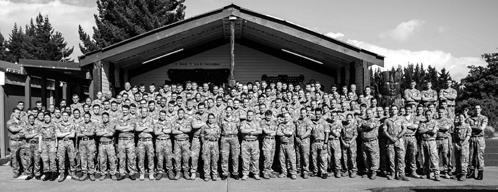
Despite being the biggest unit in brigade, it is rare to see large numbers of 1CSR personnel in one place.
The 1CSR regimental week pulled signalers, intelligence operators and our logistic support personnel out of their windowless caves across Burnham, Trentham and Linton to participate in a series of activities.
The 1CSR Regimental Week was an enjoyable experience, conducted for the first time since 2019. The celebrations were conducted in Waiouru, which gave individuals from different sub-units an opportunity to reconnect, get to know each other, and be together as a Regiment. Regimental Week 2024’s main focus was for 1CSR to spend time as a unit and enhance Esprit De Corps. To achieve this, it was split into three parts; Cultural Day, The Right of Line Competition and the Unit Function conducted at the Waiouru Officers Mess. The Cultural Day gave us all an opportunity to receive guided lessons on not just the basics of Te Ao Māori, but also a deeper insight into the foundation of Te Tiriti O Waitangi and how that applies to us as a modern day army and organisation.
This discussion included the use of Slido, allowing personnel to anonymously ask questions, and provided an open forum for all personnel to feel their views were heard. At the closing of our more theory-based lessons, we were taken back to Rongomaraeroa-o-ngā-haue-whā (NZ Army National Marae) the spiritual home of Ngāti Tūmatauenga. We learned and became proficient in the newly published 1CSR haka, formed as a way to cement our regimental bond between our sub-units.
The week also included an Amazing Race, run by 5 Signal Squadron (formally 3 and 4 Signals Squadrons) a quiz and a function in the Waiouru Officers’ mess. The prize giving ceremony named 5 Signals Squadron as the current winners in the right of line placings and although well deserved, gives the rest of us more drive to come and win it back.
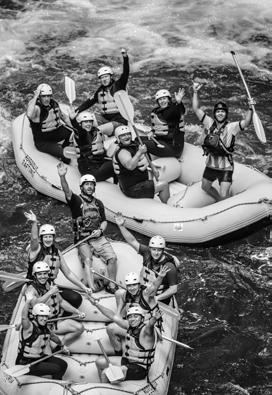
1 CSR Regimental Week was my first experience, as a new Young Officer, of the Regiment’s culture. Stepping into a 5 Sig Sqn Troop Officer role I have been able to observe the existing sub-unit culture, in which hardworking soldiers in their chosen trade environment have really impressed me.
Directed by our OC to blend competitiveness with enjoyment, Tuesday in Waiouru began with briefings and collaborative activities, fostering open conversation at all levels. Notably, there was a strong push to further integrate Te Reo Māori into the Regiment’s future plans, setting a clear direction for cultural inclusivity. The afternoon at the National Army Marae involved 1 CSR Haka practice, stories of mythology, and the history of the Māori identity within the New Zealand Army.
Wednesday unfolded with sports day including volleyball, touch, basketball, and football, with 5 Sig Sqn dominating. This created an environment for friendly competition, and encouraged social connections between sub-units.
Thursday involved a Rogaine-style adventure race. This further tested teamwork and determination with 20 plus kilometres ran in the afternoon heat of the WMTA, and difficult problem solving tasks completed. To see my 5 Sigs right of line team motivated by pride and competitiveness was rewarding. My introduction to Regi Week at 1 CSR was an illustration of the regiment’s direction, culture, and unity. The emphasis on people and their collective contributions highlighted the success of the week.
HQ 1 CSR, including subunit HQ pers from the regular and reserve force, assembled in the ANZAC Room to commence the Command Hui with a performance under pressure review session. This aligned with the content the New Zealand Army Leadership Centre facilitates with junior leaders at the Lead Teams transition. The session began with pepeha, acknowledging the importance of identity both for building bicultural competence and strengthening relationships that underpin resilience. The session concluded with a brief discussion of Te Whare Tapa Whā, as a more holistic way of viewing performance under pressure as an exercise in enhancing our taha tinana (physical), taha whanau (relationships), taha wairua (spiritual and values) not just the taha hinengaro (mental and emotional).
An update was provided on the direction HQ 1 NZ Bde is heading, detailing the role 1 CSR will likely take in the “Year of the Battlegroup.” This provided the backdrop for subunit briefs, budget guidance and training synchronisation. The importance of cultural uplift for the unit, anchored in Kia Eke and leadership development was emphasised as a focus point. The participants discussed unit culture through analysis of the outputs from the Regimental Week culture workshop. They identified the underlying beliefs and assumptions that the unit must protect, establish or challenge to maintain an inclusive, supportive and operationally-effective unit culture. The HQ was then split into two teams which would go head to head in a mentally challenging competition. This involved brain power, thinking out the box and working as a team to solve some very tough riddles and problems. The aim of the game was to escape first, the Taupo escape room challenge made for some good laughs, got the team working together… mostly, saw differing approaches in problem solving and made it quite clear that not every problem can be solved by brute strength. Both teams successfully escaped seeing new bonds formed, with a greater understanding of team dynamics within the HQ.

20 years has passed since we deployed. Join us for a fun, informal get together to reconnect and remember. Partners welcome.
February 8th, 2025, 1800
Christchurch. Exact location TBC.
Organisers currently booking venue therefore likely to be approximately a $20 cost for catering and venue. RSVP’s essential prior to 30.11.24.
RSVP to Genevieve Craddock and Rachael Gill on bombibear82@mail.com Every
My introduction to Regi Week at 1 CSR was an illustration of the regiment’s direction, culture, and unity.
– A Young Officer
Following their applied team building in the outdoors, 1 CSR HQ pers reviewed their Hogan profiles to identify strengths, gaps and complementary dynamics within the unit leadership as a whole and subunit command teams specifically. This involved considering how the headquarters may help or hinder the implementation of the CO’s command philosophy. Command Hui participants acknowledged that her four quadrants of manaakitanga (respect), wairua (wellbeing), collaboration (mahi tahi) and noho haepapa (accountability) have become the de facto unit principles.

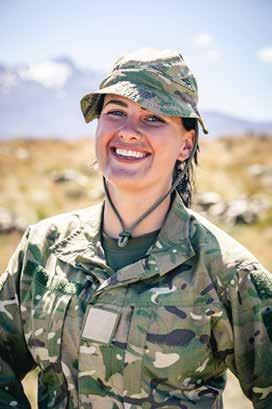
When Private Lyndi Le Fay isn’t studying the final frontier, she’s relishing her role as a New Zealand Army Reserve Force soldier and encouraging other young women to follow in her footsteps.
Brought up in Queenstown, Private Le Fay is in her final semester at Auckland University, finishing her graduate diploma in earth sciences with a focus on space science. She’s been a reservist with Auckland-based 3rd/6th Battalion for nearly two years, and will soon be joining the New Zealand Defence Force (NZDF) full time.
“Joining the Reserve Force seemed like a good option to get my foot in the door and understand how the military works,” Private Le Fay says.
“It’s given me the confidence, leadership skills and the ability to do something so completely different from every day civilian life.”
As well as her reservist duties, Private Le Fay is a Recruiting Ambassador for the NZDF, which sees her inspiring other young women to consider careers with the Defence Force.
She’s engaged with female high school students through the Royal New Zealand Navy’s annual School to Seas programme, which focuses on Science, Technology, Engineering and Maths (STEM) opportunities for women in the Navy. And last year, Private Le Fay helped run the Royal New Zealand Air Force Innovation Challenge.
It’s given me the confidence, leadership skills and the ability to do something so completely different from every day civilian life.
– PTE Lyndi Le Fay
When she talks to young women about the NZDF, Private Le Fay is very open about her own experiences studying STEM subjects and being in the military.
“I didn’t have a good experience at high school, I was not one of the popular kids. I focused on my study and it has led to amazing opportunities in my personal life.
“I tell people that high school isn’t everything. What you do in your life, extracurricular-wise, academic-wise, is much more important than what people think of you.”
She said quite a few of those young people she’s met through her Recruiting Ambassador role, have since reached out to her via social media.
“A few have become Navy officers, telling me I was the reason they joined.”
Private Le Fay said on average, Reserve Force training takes up between 20 and 30 days a year.
“If you’re doing reserve courses it can jump up a bit. This year has been different, in that I got an opportunity to be a second-in-command during a Reserves Infantry Corps Training.
“I was very privileged to do that as a private. And it’s been a bit of a running joke because I do so much more in my roles with Recruiting.”
She thinks everyone should try their hand at life in the Reserve Force, even if they are a little hesitant about joining the NZDF.
“It’s a great way to learn soft skills, like team leadership and being an efficient follower. You work with a highperforming team in stressful situations, which gives you endurance, resilience and a lot of self-confidence.
“You make new friends and have really good experiences. The opportunities are just endless.”
Private Le Fay said she’s very excited about joining the NZ Army Regular Force in a few months’ time.
“As it happens I come from a military family. My grandparents, cousins, uncles –there’s a lot of military history in my family.
“Reserves has given me a great start, given me skills to navigate life.
“There have been situations I have got into, where having that foundation of mental fortitude has helped me get through some tough moments when things are thrown at you.”
ARMY IS IMPLEMENTING THE DECISIVE ACTION TRAINING ENVIRONMENT [DATE]_

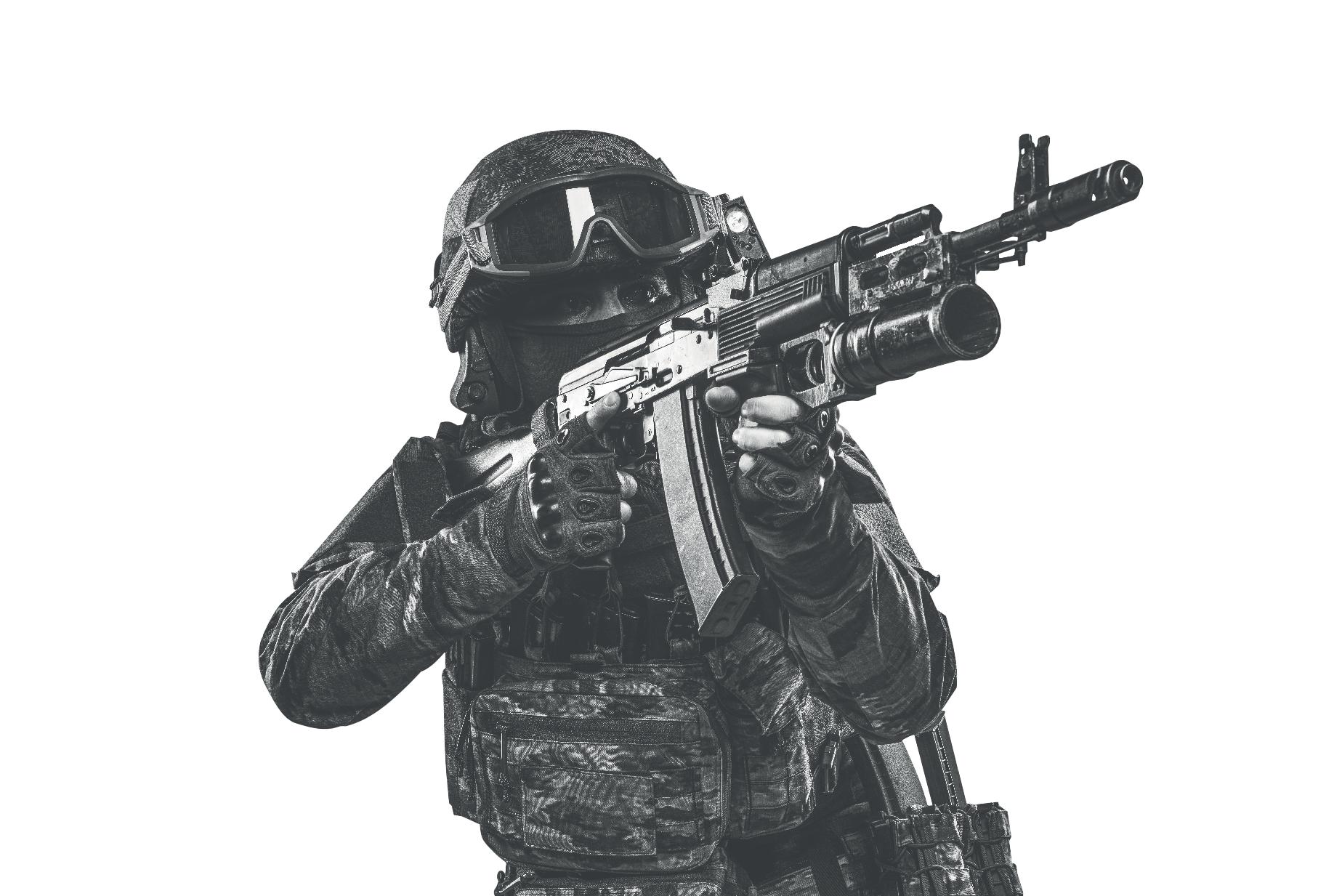
DATE WILL PROVIDE A COMPREHENSIVE LIBRARY OF THREAT GROUPS AND TRAINING ENVIRONMENTS, REPLACING THE MUSORIAN ARMED FORCES AS ARMY’S NEW LAND ADVERSARY SYSTEM FOR INDIVIDUAL AND COLLECTIVE TRAINING_
FOR MORE INFORMATION VISIT_
DATE.ARMY.GOV.AU
The NZ Army is introducing the Decisive Action Training Environment (DATE) to support individual and collective training in order to better align us to our FVEYs partners, notably Australia under Plan ANZAC.
DATE is a library of geographically unique operating environments that are representative of real-world conditions, underpinned by realistically modelled REDFOR. NZ Army will utilise the DATE INDO-PACIFIC (DATE-IP) Operational Environment (OE) which is most relevant to our outputs. DATE-IP and associated REDFOR will continuously evolve to reflect the ever changing contemporary geostrategic situation which will ensure that Army is able to conduct both relevant and challenging training.
The rollout of DATE-IP is being led by the Training Environment Support Cell (TESC) currently under MCTC with a focus on individual training in 2024. This work has been heavily supported by the TRADOC School houses, the AGS Army Transformation Team and the ADF’s Training Adversary Support Centre (TASSC) to which the NZ TESC will integrate moving forward.
Accomplishments so far include delivery of the DATE-IP Train the Trainer Package to key personnel in 1 (NZ) Bde and TRADOC, a re-write of the REDFOR Battle Book by SMIS to transition away from the current OPFOR, and a re-write of the BLUEFOR Battle Book by Tactical School supported by Log Ops School and the School of Military Engineering. Both of these products lean heavily on the ADF COAC REDFOR and BLUEFOR Battle books to maximise synergy between NZDF and ADF. Additionally, Tac School with the support of the TASSC have drafted a new overarching
scenario for individual training called Op SWIFT DEFENDER, which is based on the ADF equivalent and has also recently completed a DATE-IP upskill package for selected personnel who will act as DS on the upcoming Grade 2 Staff and Tactics course. These products are displayed on an NZDF web page that is hosted by the ADF TASSC website at https://date.army. gov.au to enhance integration, ensure currency and facilitate ease of access.
This work has ensured that the key product required for the implementation of DATE-IP by Army for individual training is now available and as such, will be utilised on courses being run by Tactical School, Log Ops School and SMIS, with the remaining School houses in TRADOC fully implementing DATE-IP by the beginning of 2025.
Regarding collective training, this year Ex Pacific Kukri 24, the Joint Readiness Exercise 24, and Ex Sari Bair 24 will utilise DATE-IP based on various scenarios and will expose approximately 33% of 1 (NZ) Bde personnel to DATE-IP. Ultimately, the intent is to better align the scenarios used for Collective Training with those utilised by the ADF and this transition will occur in due course.
By December 2024, DATE-IP will have become an essential part of the NZ Army training system. COL Aidan Shattock, Assistant Chief of Army Training (G7) highlighted the importance of DATE-IP in relation to Plan ANZAC.

“In being able to maintain a common operating environment, we will enhance our ability to exercise and operate with our closest partners. The excellent work our DATE-IP team have done with their Australian counterparts in Forces Command will enhance our ability to meet interoperability and interchangeability milestones for the MIBG to work within an Australian Brigade construct. Simply put, DATE-IP enhances our operational readiness.”
In line with COL Shattock’s sentiments, Brig Matthew Weston, LCC said: “I would like to acknowledge all those involved with the DATE project to date, especially the staff in Tac School, Log Ops School and SMIS who have worked tirelessly to ensure that DATE-IP is successfully incorporated into their upcoming courses this year. The successful implementation of DATE-IP into NZDF is a crucial step in ensuring that we maximise interoperability with and remain relevant to our key partners within the FVEYs community moving forward.”
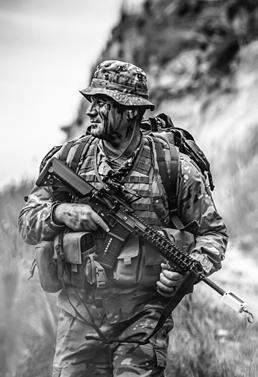
In the lead up to a whole of Army Reserve Force exercise, Exercise Tauwharenikau, based in Waiouru in May, we’ll be speaking to some of the Reserve Force personnel attending. The exercise will include Reserve Force personnel from the Australian Defence Force, and will be the first of this scale in over 20 years.
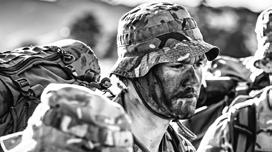
How long have you served in the Reserve Force and what made you join?
I’ve been in the Reserve Force for almost three years now. I attended my cousin’s graduation when he marched out on basic, I think I was about 12 at the time. I remember thinking to myself ‘I’d like to do that someday’. When I did eventually decide to join it was because I wanted to work in a team environment and complete something I knew would be challenging.
What is your civilian occupation?
I’m in my fourth year studying full-time at Victoria University of Wellington undertaking a BA & BCom conjoint degree. It’s quite full on but I like the flexibility the university offers. It allows me to get a lot done each day. I’m also a senior lifeguard at Karori Pool. In this role I will often be called upon to run shifts.
I love working at the pool because there’s a great sense of community there and it’s good to be able to provide people with not only the facilities we offer but also that sense of community. What are you looking forward to most about Ex Tauwharenikau? I’m most looking forward to the live firing component. The last time I did live firing was on Exercise BAPAUME over a year ago which was cut short due to the Cyclone Gabrielle. I’m also looking forward to the scale of it. It’s a Reserve Force exercise with each ResF Battalion and integrated units contributing elements, and I believe there will be a platoon of Australians as well. I think these two elements will make the training feel very real.
What do you think might challenge you on the exercise and what are you doing to prepare yourself to best face this challenge?
In the build up to this exercise, we’ve had a number of trainings and exercises to slowly prepare for it. Because of this, there will be a high expectation for everyone to perform. What I’ve done to prepare is made an effort to attend every training so that I’m confident in my soldiering skills. It will also be the first large scale Battalion exercise I’ve been a part of. By putting in the effort ahead of time to get to all of the trainings I’m confident I’ll be in a place where I can tackle whatever challenges come up when I get there.
How long have you served in the Reserve Force and what made you join?
I joined up roughly a year ago now. Previously, I had been in the Regular Force for 10 years then 10 years contracting. Once the dust had settled, I felt I was missing something and decided to venture down the Reserve Force (ResF) route and see what it entailed.
What is your civilian occupation?
I currently work as a project manager for Red Wolf High Level Security.
What are you looking forward to most about Ex Tauwharenikau?
If I’m able to be a part of Ex Tauwharenikau (work is demanding at present, with a lot of projects to juggle), it would be working with a great bunch of people who want to be there. Being that the military isn’t their first occupation, when on exercise they really do give it their 110%.
What do you think might challenge you on the exercise and what are you doing to prepare yourself to best face this challenge?
One of the most challenging aspects of my job is taking charge of my section and leading them to successfully execute the mission at hand. As someone from an ex-armoured background, I had to recall back to my basic infantry training skills and put them into action. However, 5/7 is made up of some truly supportive colleagues, and without their guidance and assistance I wouldn’t be able to keep up with the pace.
For anyone considering reenlisting as ResF, give it a go, it’s not what you think or thought while serving with the RF. I’d sum up ResF soldiers as men and ladies from all walks of life that want to be a part of a mission that matters.

OC B Coy 2/1 RNZIR Major Waaka Parkinson (left) recently accompanied his partner in the City 2 Surf fun run. He pack marched beside his partner as her support person.
We had some really good interactions with members of the public during the walk and post the finish line.
– Major Waaka Parkinson
Deputy Chief of Army Brigadier Rose King presented Reservist Captain Jack Gradwell with his prize for winning the Army’s Business Excellence innovation award.
CAPT Gradwell’s submission was based on an integrated data infrastructure to enable better evidence-based decision making. He is currently aide-de-camp to the Governor-General.
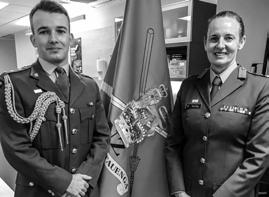
2nd /1st Battalion is commemorating its 50th anniversary and invites all past and present members of the Battalion to join in a weekend of celebration.

If you are interested in attending the weekend, which will include a charter parade, open day, a formal function, and a church service, then please pre-register at nzdf.mil.nz/2nd-1st-50th
You will then be sent further information to complete your registration.
Registrations close Sunday, 26 May.
Book reviews by
Jeremy Seed
Arguments and Alternatives – ‘Is This Belief in the Military Justified?’
By Griffin Manawaroa Leonard, Joseph Llewellyn and Richard JacksonBWB Texts #102
Published by Bridget
Williams Books
The New Zealand Wars
By Gavin Bishop Published by PuffinBWB Texts are a series of what are described as “short books on big subjects for Aotearoa New Zealand”. At 140+ pages, it is indeed short and the abolition of the NZDF is potentially a big topic and directly about us, what we do, why and whether it is worth it for New Zealand.
The intent of BWB texts is to provide introductions to, or explanations of concepts, theories and ideas in such a way that the reader is both educated and made to think. This book certainly achieves those objectives in spades. As you would expect in a book of this size, the topic is presented and discussed at a macro level, and there isn’t time nor necessity for a deep dive into a lot of the practical minutiae.
To the closed minded, it would be easy to dismiss a tome with a title like this, written by such a trio as nonsense or ‘woke garbage’. Chinese philosopher and strategist Sun-Tzu, who appears in almost every military reading list, sagely advises his reader to “know your enemy” and in this sense, if you are a military professional it is probably not a bad idea to cast an eye over Abolishing the Military with Sun-Tzu’s advice in mind. Personally I found the points made which questioned the cost and ultimate utility to the country of the NZDF to be compelling and worthy of deep consideration. Far from being the angry, anti-military rant of peaceniks or hippies, the book poses and examines a well structured series of valid and relevant questions about the NZDF and its ultimate value to New Zealand both internationally and domestically.
The authors are very clear about the utility of the NZDF in certain areas like disaster relief and border surveillance. In this respect they concede there is a need for some trained, suitably equipped formed body to exist to perform these tasks, they just don’t think the NZDF is the most cost effective or appropriate organisation to perform those services.
Where their arguments seem weakest is around peacekeeping and international deployments – the authors definitely would have benefitted from having someone with NZDF experience to add some insight into basics like how often “peacekeeping” is anything but and how many deployments have nothing to do with the UN.
Overall, I found the book to be compelling, making a wide variety of valid points about the cost and relative value for money of the NZDF. The book provides plenty of food for thought and is highly recommended for anyone looking for something to make you think and confront some, at times, uncomfortable truths.
Gavin Bishop ONZM is an established New Zealand children’s author and illustrator who over the last few years has developed a reputation for writing and illustrating large format books about aspects of early New Zealand history. In 2018 and 2022 his books; ‘Aotearoa: The New Zealand Story’ and ‘Atua’ respectively won the annual Margaret Mahy award for best children’s book.
Patu is his latest work and tells the story of the New Zealand Wars. Bishop doesn’t treat his readers as idiots and while he is writing for a youth audience, he does a great job of story telling and his text is enjoyable and informative. I read Atua to my youngest son and I suspect I learned more than he did and we both enjoyed the stories. Bishop is a talented illustrator and being partly of Ngati Awa and Tainui descent, is more than comfortable and confident with illustrating Maori themes. The book is visually striking and heavily illustrated with each page being a mix of relevant pictures and text. The constantly changing page layouts mean that graphically each new page you turn, tells a different story. Bishop skilfully uses a limited palette and this adds to the dramatic impact of the book. Three four-page fold outs are used to great effect to depict specific battles and provide great detail of the ground being fought over.
Running to 64 pages, Patu tells the story of the wars in simple, easily followed, chronological order. The book begins with overviews of the 1835 Declaration of Independence and 1840 Treaty of Waitangi to provide context for the Maori attitudes toward colonisation and some of the origins of conflict. Bishop then guides the reader through conflict in Wairau, Te Tai Tokerau, Wellington, Taranaki, the Waikato, Tauranga and concludes with sections on the rise of Maori prophets and their roles in conflict.
Throughout the book, Bishop parallels the development of conflict with the births and lives of his own tipuna who in many cases were living in close proximity to, or were impacted by the fighting. Each war, or phase of conflict involved different Iwi, Rangatira and colonial forces and these individuals and groups are detailed in the relevant chapters.
Patu condenses a wealth of information into a superbly illustrated, compelling, very readable and informative book. The information is presented more comprehensively than a simple ‘soldier’s five’ on the New Zealand Wars, but the wars themselves were complex and far from straight forward. Despite being marketed as a childrens / young adult book, anyone of any age, looking to gain a good, basic understanding of the Who, What, Why, Where, When and How of the New Zealand wars needs to start with Bishop’s Patu
The Inter-Services Softball Tournament is back, after a fouryear hiatus due to the pandemic and our commitment to Operation PROTECT. The New Zealand Army Men’s and Women’s teams returned to the diamond, in what was a successful week for Army Softball.
This year’s tournament saw teams from all services travelling to Devonport Naval Base, where they would meet and go to battle with bat and ball. The tournament was laid out in two days of round robin play, followed by a day of play-offs. Any team who managed a clean sweep in the first two days would guarantee a trip straight to the finals, and so the goal was clear for our NZ Army teams.
The first day of ball saw the men playing two back-to-back games in the morning. First up was the RNZAF, and this game was the first full shakeout for the team. A great pitching game from the team captain, combined with excellent batting from the team in the second innings, including a homerun, closed out game one with a final score of NZ Army 6, RNZAF 0. Player of the game was awarded to LCPL White-Hodge for his efforts on the mound keeping the RNZAF hitters on the bench. The NZ Army team managed to keep the Navy from reaching home base all day, with a dominant 5–0 win to close out day one. Player of the game was awarded to PTE Brock Coulbeck. One more win over the RNZN on day two would see the NZ Army sail straight to the finals.
Amry women kicked off the interservices tournament facing off against the RNZAF, leaving an indelible mark on the diamond. SGT Cherie Field-Taylor who showcased her hitting prowess starting the game with a home run. Supported by her teammate’s impressive hitting skills, Army dominated the game securing a commanding victory with a final score of 22–9, setting the tone for the rest of the competition that they were there to defend their title.
The second day would see a repeat of the matches played on day one, and both NZ Army teams needing wins over the RNZN to go straight through to the finals. Game three for the men’s team would not be as easy as day one against the RNZAF. The ball game would go all the way down to the last innings where the Army needed to pick up their performance on the plate.
Game three for the NZ Army women’s team saw them continue their impressive run as the once again faced off with the RNZAF. The women, despite a slow start, delivered another commanding performance on the diamond by putting on a hitting clinic, with every member of the team contributing to the slug fest.
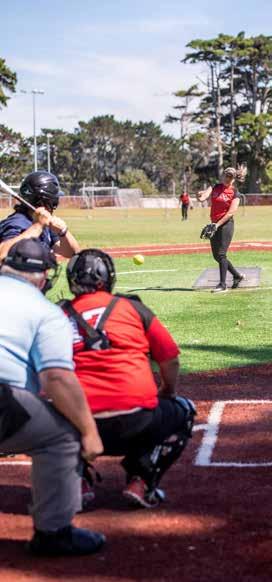
On a highly anticipated finals day, the stage was set for two epic showdowns. With the NZ Army teams being undefeated to this point, the day would start with our women versing the RNZN. The NZ Army pushed through fatigue and injuries for what would be a full seven innings game, and with the wisdom and experience of senior players and coaches, they executed sound strategies against the Navy’s top slugger in the fifth and seventh innings. This may have played a major part with the NZ Army women emerging triumphant, overcoming the RNZN for a hard fought 9–7 win, and our first piece of silverware for the tournament.
The final game of the tournament was set to be a big one, and would see the NZ Army face off against the RNZAF one last time. The Army quickly took off, with the team wasting no time getting runners on base and in to score early. The men were able to close out a perfect tournament for both teams, staying undefeated throughout and bringing home most of the awards the tournament had up for grabs.
I’m looking forward to the Army. I’ve always been pretty active and physical.
– Tom Lee
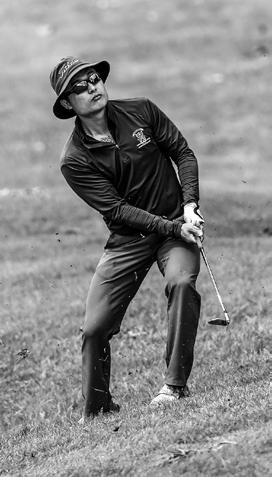
The NZ Army will be getting a prized double whammy when Tom Lee begins his four-year return of service next year. A doctor, he will be doing his initial officer training and will also probably be the best golfer to wear an army uniform, having had a handicap as low as +4.8 which is near professional calibre.
Lee, 30, who is in his final year of training at Christchurch Hospital, was the 2024 Army champion golfer when he played for the Southern region in the Army interregional golf tournament at Shandon, Wellington, in January.
There in the strokeplay he had rounds of 69, 72, to head off an Australia officer on exchange, Maj Brett Edmonds, by two shots. Unbeaten Lee also won all of his foursomes and matchplay rounds.
Unfortunately his hospital duties, up to 60 hours a week, mean he can’t represent the Army at the upcoming interservices tournament. Next year, when he’ll be in uniform, should be different.
After completing the Officer Selection Board process in 2018, he was offered a position as a Medical Officer Cadet, the NZ Defence Force having helped fund him through medical school.
Lee could just as easily have gone down the professional golfing route, which he did consider, but knew it “needed constant practice and dedication”. Now on a +1.9 handicap at Christchurch Golf Club where he has shot 64, he has been the Otago and Canterbury No 1, has a world amateur ranking and has featured in Charles Tour pro events.
As soon as his family emigrated from South Korea in 1995, his father introduced him to golf at the toddler age of two in Rotorua. He and his brother Peter were always pressured to be pro golfers and Peter did try that. Interestingly, all of their male relatives in Korea have done compulsory army service.
The Lee boys went to Western Heights High School, the alma mater of former All Blacks captain Wayne Shelford, but the Lee boys were often there only two or three days a week with golf taking priority. Tom left school at 16 and a year later he stopped playing.
“Under pressure to play I never enjoyed it that much,” he said. “I took a break and went powerlifting and bodybuilding.” At his peak weight of 90kg he could squat 290kg, using knee wraps, and bench press 155kg.
“I only got back into golf in 2020 when Covid happened after an eight-year break.”
“I’m looking forward to the Army. I’ve always been pretty active and physical.” Neither golf nor medicine featured when he went to work at Rotorua Pak’n Save after leaving school. After six years he was duty manager.
“I didn’t want to go down that route. I wanted to go to university, but I saw students come back to us after getting degrees with no job.”
So medicine appealed. He put his head down and got his NCEA levels 2 and 3 by correspondence so he could enter university and in his first year at Otago University his 96 percent in health sciences shot him into medical school for the 6-year degree.
He said dealing with customers and employees at Pak’n Save has helped him with hospital patients and should equally translate to the Army.
So should his experience with university medical students associations and on Korean students association executives. He became a NZ citizen in 2012.
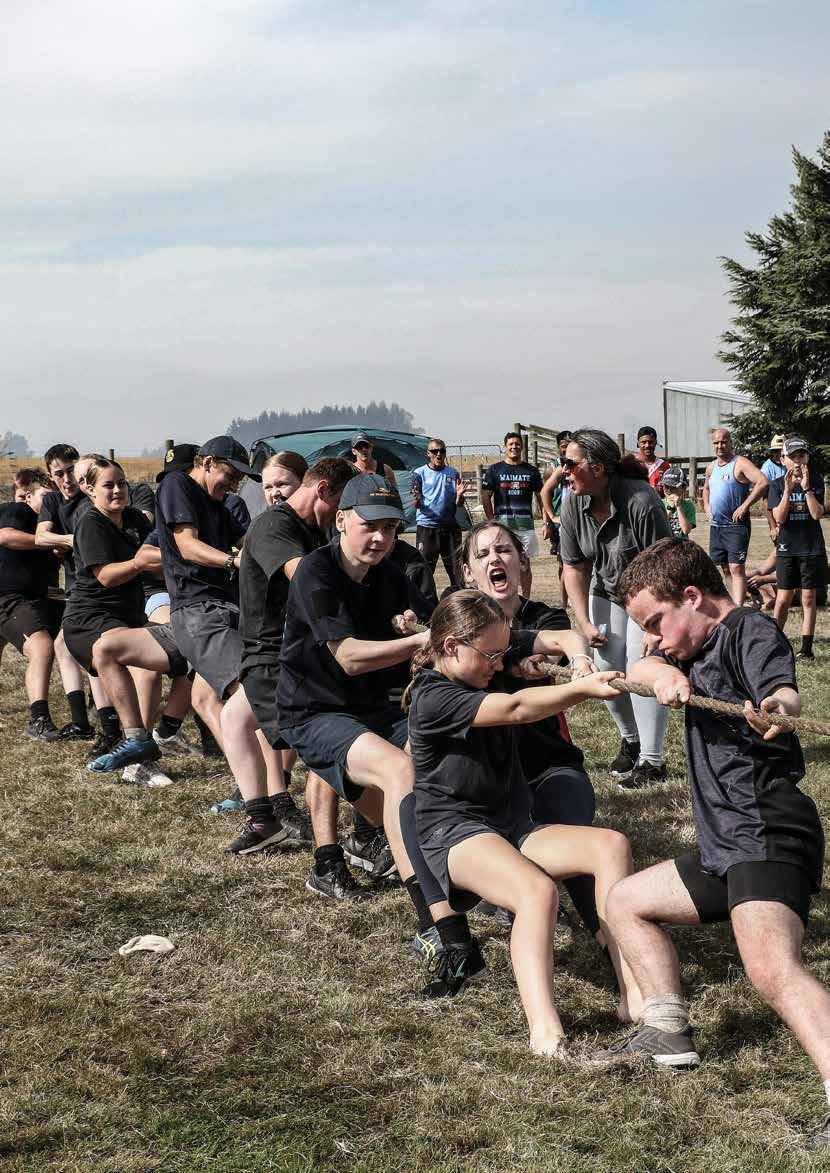

Waimate war hero Eric Batchelor would have been proud of the fierce sporting competition that took place in his hometown recently.

The Eric Batchelor Cup (EBC) is a 2/4 Battalion biennial sports competition played over three days in honour of Sgt Eric Batchelor DCM and Bar, MiD. The competition was instigated in 2011 to commemorate his passing the previous year. His widow, Mrs Thurza Batchelor presented the cup to the winning team, Headquarters 2/4 Battalion.
Eight teams made up of 120 competitors competed for the coveted cup. Five teams from 2/4 Bn (including ARes soldiers from 3 CSSB, RNZAMC and 3 Fd, ER Sqn), competed against teams from Waimate High School, Waimate Rugby Football Club and a combined squad of Timaru and Christchurch Cadets (Navy, Army and Air).
The tug-o-war knock out proved, as always, to be the best of spectator sports, with the Mayor of Waimate adjudicating a series of fiercely fought matches. A superb final between Waimate Rugby Club and the victors, HQ 2/4 Bn, was eclipsed by the junior final between Waimate High School and NZDF cadets. The cadets won with two epic pulls to nil.
On the last day of the competition, 2/4 Bn paraded, alongside the Waimate RSA and the Waimate High School team at Waimate cemetery. Mrs Batchelor accompanied by family, laid a battalion wreath at Eric’s grave followed by the presentation of Defence Service Medals to five Unit soldiers.
3 CSSB Regular Force Chefs cooked 610 meals for the duration of the competition, producing outstanding service which was appreciated by all participants and members of the community.
Mrs Batchelor and her family thanked those who took part.
The winners:
Football – B Company
Touch Rugby – Waimate Rugby Club
Burrows Bayonet – A Company
Netball – Waimate High School
Volleyball – Waimate Rugby Club
Tug-o-War – HQ 2/4 Bn

About 80 competitors including reservists battled it out in the Linton Fitness Challenge recently.
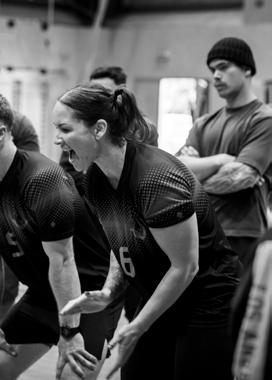
The units taking part included 1 RNZIR, 16 FD REGT, QAMR, 2 ER, and LOTC. And the winner? 1RNZIR.
The workouts were:
• a full team of 6 workout using an apparatus called the ‘worm’ (this workout was aimed at testing team cohesion, mental resilience, muscular endurance and coordination).
• a trios pool/ swimming workout (3 out of the 6) and aimed to test cardiovascular endurance, speed or quickness and muscular endurance.
• another trios workout involving rope climbs, the assault bike and wall balls –this metabolic conditioning (METCON) combined skill, speed, strength and cardiorespiratory conditioning.
• a pairs workout involving running and weighted exercises, testing cardiorespiratory fitness and muscular endurance (in the legs especially).
• four competitors of the team to reach their maximum lift on the bench press with correct technique (the main strength component of the day).

One of the competition organisers LCPL Caitlin Snyman said one of the main differences in the competition this year was the sponsorship provided by Xplosiv Supplements Palmerston North.
All competitors received a shaker cup and electrolytes each before even beginning the day’s activities!
– LCPL Caitlin Snyman


Army won the inter service rugby league competition, leading 14 points to 10 at the half time whistle. The final score was Army 32, Navy 18.

The first game saw Air Force vs Army, with Army winning 30–10. It was a hard game that saw Air go out to a quick 6 nil lead before Army found their mojo and scored. Air followed up with a converted try to lead at the break 10–6. Army just needed to trust their abilities and combinations. They did this in the second half with the Army team scoring what seemed to be at will. The score did not reflect the game as Air threw everything they had at Army. Army was too strong with combinations working scoring 5 unanswered tries in the second spell.
With both teams down on subs, Army loaned a player to Air to even up team numbers. Another tough game with big hits and silky skills on show. Air again struck first, but could not convert in the windy conditions. Navy then struck with 2 converted tries before Air closed out the half with another unconverted try. Half time 16–14 to Navy. Navy was first to score in the second half with 2 converted tries before Air scored. Navy had a couple of injuries reducing their bench and Air struck with a converted try before Navy scored again. With Navy hurting and struggling with a couple of players down with cramp Air struck with 2 converted tries. Navy held on by the skin of their teeth to the final whistle.

The Combat team was the winner in a closely fought competition when the 2024 Army Hockey Regional Tournament was held in Palmerston North recently.
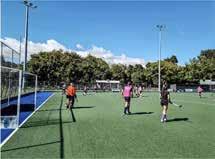
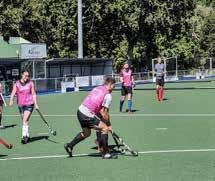
The event consisted of three days of hockey, with two days focused on skills refresher, drills and scrimmages, culminating with the tournament game which pitted Combat versus Combat Service Support trades. The tournament game was a close affair, with Combat taking an early 2–0 advantage. CSS fought their way back in to the game though, and heading into the final quarter the scores were locked at 2–2. Combat scored a third goal early in the final quarter, and defended against multiple attacks over the final ten minutes to upset the heavily favoured CSS team and secure the silverware. PTE Taryn Doyle scored two goals for Combat, with PTE Matthew Dellow scoring the other, while PTE Harvey and LCPL Reed scored a goal each for CSS.
Following the tournament, the NZ Army Men’s and Women’s Hockey teams which will be travelling to Australia to compete in the Australian Defence Force Hockey Association Combined Championships prior to competing in the NZDF Inter-service Hockey Tournament in July were named.
MENS TEAM:
CPL JONES, LCPL GILMORE, SGT CULVER, LCPL WILLIAMS, CAPT CADE, LCPL HORSLEY, LCPL HIRST, MAJ HOULAHAN, SPR DOWNS-WILLIAMS, PTE HILL, MAJ BLACKBURN, LCPL COLLINS, PTE ORR LCPL GORDON, SGT HILBOURNE, PTE DOYLE, PTE SCHNAUER, PTE LINDBERG, LT CAPIZZI, LCPL TUKAPUA, PTE WINEERA.
NON TRAVELLING RESERVES:
LCPL LITTLEJOHN, 2LT SINGH, CAPT WILKIE, SPR NARASY, PTE MUGGLESTON, PTE DELLOW, SSGT LATHAM-PROKOPOWICZ, LCPL BASTERFIELD.
WOMENS TEAM:
CPL LAWSON, MRS MORICE, LCPL BLACKWOOD, LCPL REED, LT CHURTON, SPR POOLMAN, PTE HARVEY, 2LT MAYNARD.
NON TRAVELLING RESERVES:
LTCOL ROPITNI, WO2 KAREKO, SPR FULLER, CPL HORTON, OFFCDT BRADY, 2LT WHYTE, LT RUSSELL.
AWARDS PRESENTED:
JHG ARMSTRONG RANGI MEMORIAL TROPHY, BEST SPORTSMANSHIP AT THE REGIONAL TOURNAMENT: 2024 LCPL B. HIRST.
CHARLIE FINLEY TROPHY, ARMY REGIONAL HOCKEY, MOST VALUABLE PLAYER: 2024 PTE T. DOYLE.
NEW ZEALAND ARMY REGIONAL HOCKEY, MOST VALUABLE WOMEN’S PLAYER: 2024 LT T. CHURTON.
INTER REGIONAL HOCKEY TOURNAMENT MENS WINNER: 2024 COMBAT.
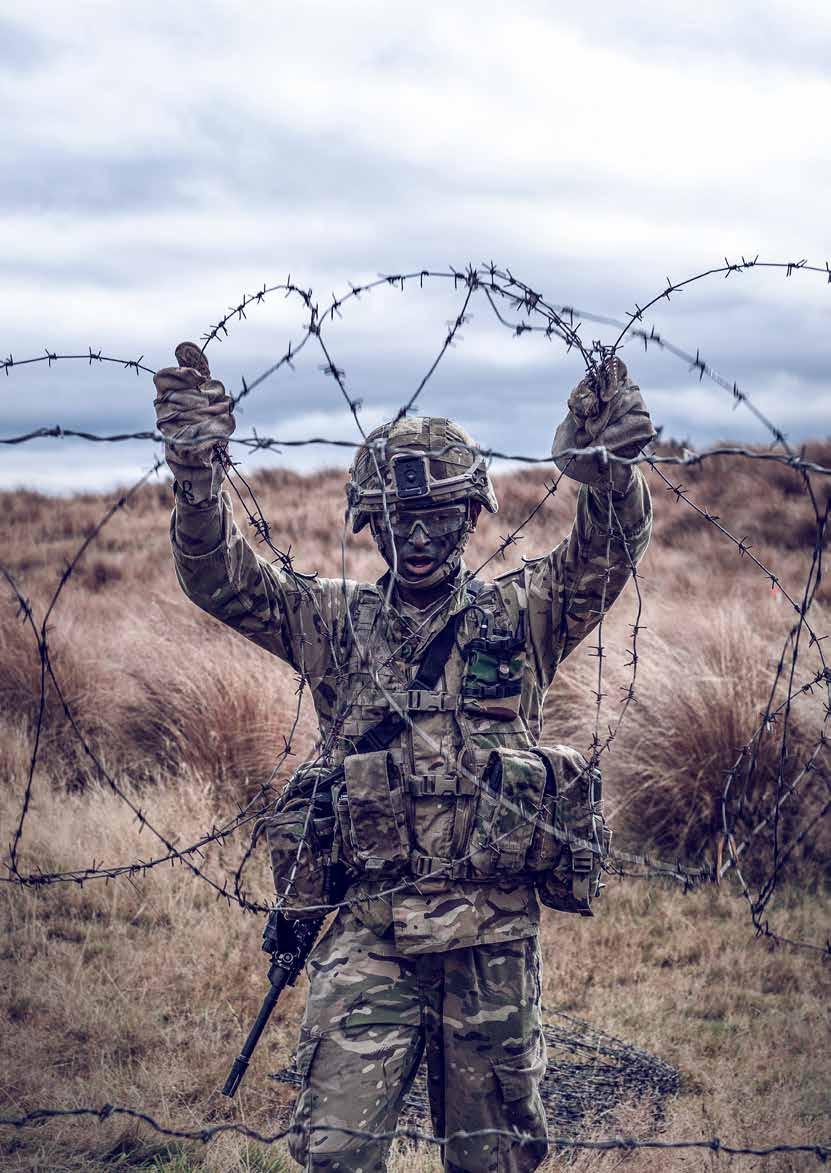
Soldiers participate in the 2024 Skill at Arms competition held in Waiouru Military Camp.
13 teams tested themselves against challenges including wiring, live assaults, manoeuvring across water, mass casualty management, IED control, night time navigation and shooting, and more.